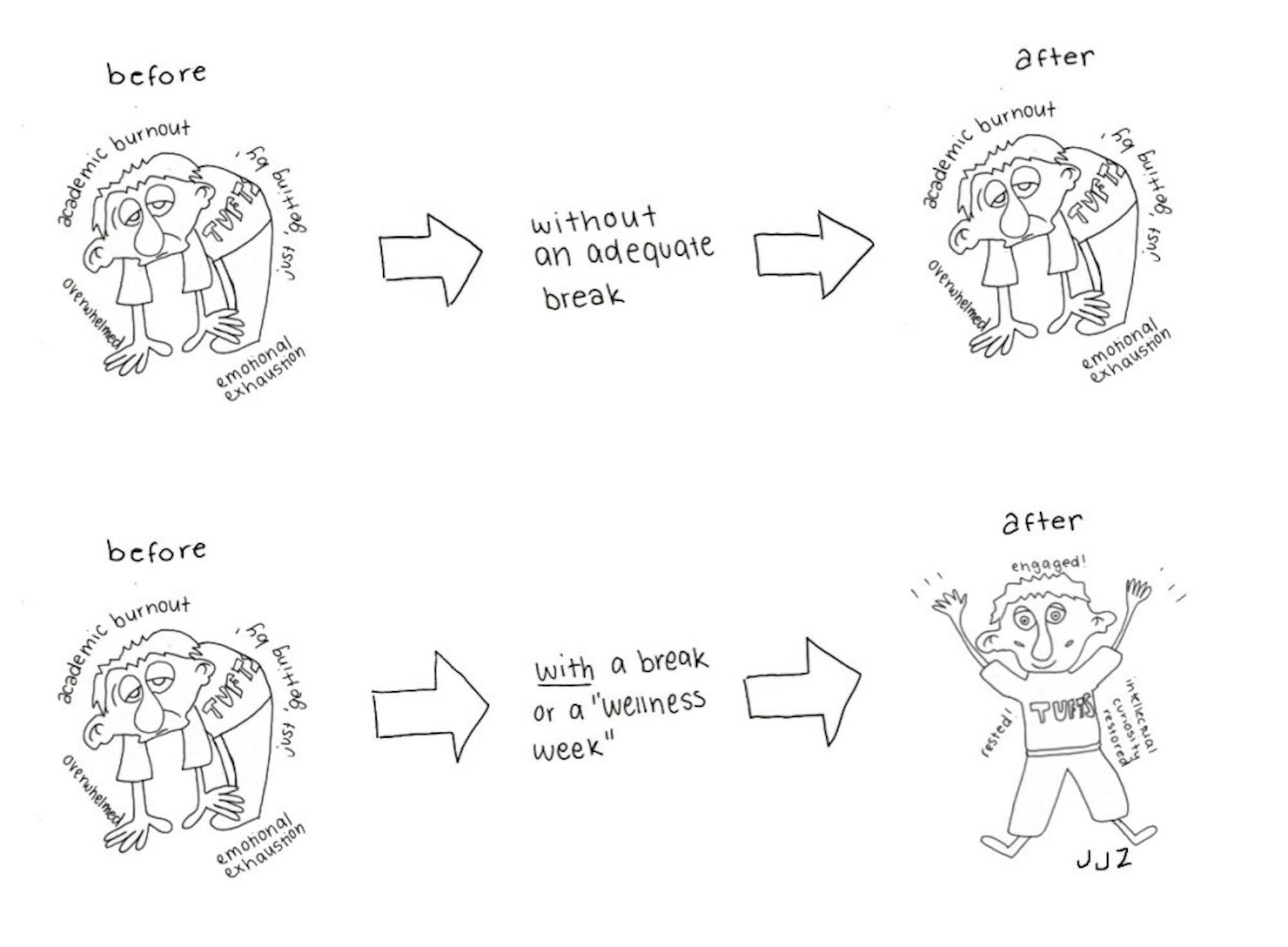This spring, we returned to campus on the heels of an extended winter break, following a decision to delay the start of the semester.This schedule allowed additional time for staggered arrivals and was vital to protecting our community’s health. However, the accompanying reduction of the traditional week-long spring break may carry consequences for student well-being.The single Friday off from classes does not provide students an adequate break to offset feelings of academic burnout and emotional exhaustion. To address these effects, Tufts should provide wellness days throughout the semester to offer students a necessary break from school.
Burnout and exhaustion at the end of a semester aren’t uncommon, yet the fall 2020 semester seemed to amplify many of these feelings to an unprecedented intensity.With the pandemic limiting the scope of on-campus social activities, many students found themselves with fewer outlets to recharge in the midst of a demanding week. Overwhelming course loads compounded feelings of stress and fatigue.While some professors have recognized the need to adjust syllabi and accommodate their course policies for their students' well-being, one glance at the academic calendar serves as a daunting reminder that there are few moments to recover during the spring 2021 semester.
A Feb. 16 article highlighted TCU Senate’s efforts to implement a Wellness Week, a gesture that would provide students a period of much needed mental rest. This initiative entails mental health and mindfulness programming, along with a request that faculty not assign midterms or exams during the proposed Wellness Week. As notable as this proposal is, it remains up to professors to participate in it. Though it may require professors to shift some scheduling or logistics, the benefits of partaking in such programming would far outweigh any drawbacks. The alternative — not having some form of a break — could have detrimental effects on students' social, emotional and mental well-being.
Without an adequate break, already-impacted productivity levels will worsen. Lack of needed rest will leave students feeling unfocused and unable to effectively complete work. Further, the inability to take a break may heighten levels of anxiety and stress. If the quality of work decreases as a result of exhaustion and stress, the efficacy of a semester without a break comes into question.
Rather than sustaining an unhealthy and unproductive academic environment, professors should see the positives in implementing a break. By doing so, students will be more engaged and motivated in the weeks that follow. A short time away from rigorous course loads would change the dynamic of the second half of the semester for the better. Instead of operating under the mentality of just "getting by," students would feel their intellectual curiosity restored.
Like Tufts, other schools had to adjust their academic calendars to factor in a late start and mitigate risks associated with student travel, either truncating or eliminating spring break altogether. Wesleyan University chose to give students a Tuesday and Wednesday off; this mid-week break appears to be an attempt to minimize student travel while also preserving a period of rest.Alternatively, Harvard University circumvented a mid-semester break all together, instead opting for “Wellness Days” dispersed throughout the semester. In both cases, these universities attempted to formulate creative replacements for the traditional spring break while still adhering to COVID-19 safety guidelines. It is within Tufts’ reach to do the same.
If the idea of a Wellness Week seems too broad or unfeasible given curricular constraints, there are alternative avenues professors could take that would have a significant impact on the mental and emotional well-being of students. In place of one class session during the week that would have been spring break, professors could provide time to check in with students and allow a space for reflection. Another alternative could involve canceling or lightening smaller assignments and homework periodically, freeing up the occasional afternoon. Students can use that time to safely connect with friends outside of class or rest.
A traditional spring break is out of the question. That being said, a period of mental rest is still possible — and necessary. Giving students time off has the power to bolster their performance and engagement in the remaining weeks of the semester. Yes, providing this break is a choice; but it’s a choice that shows students that their professors are receptive and understanding of this unparalleled student experience.






